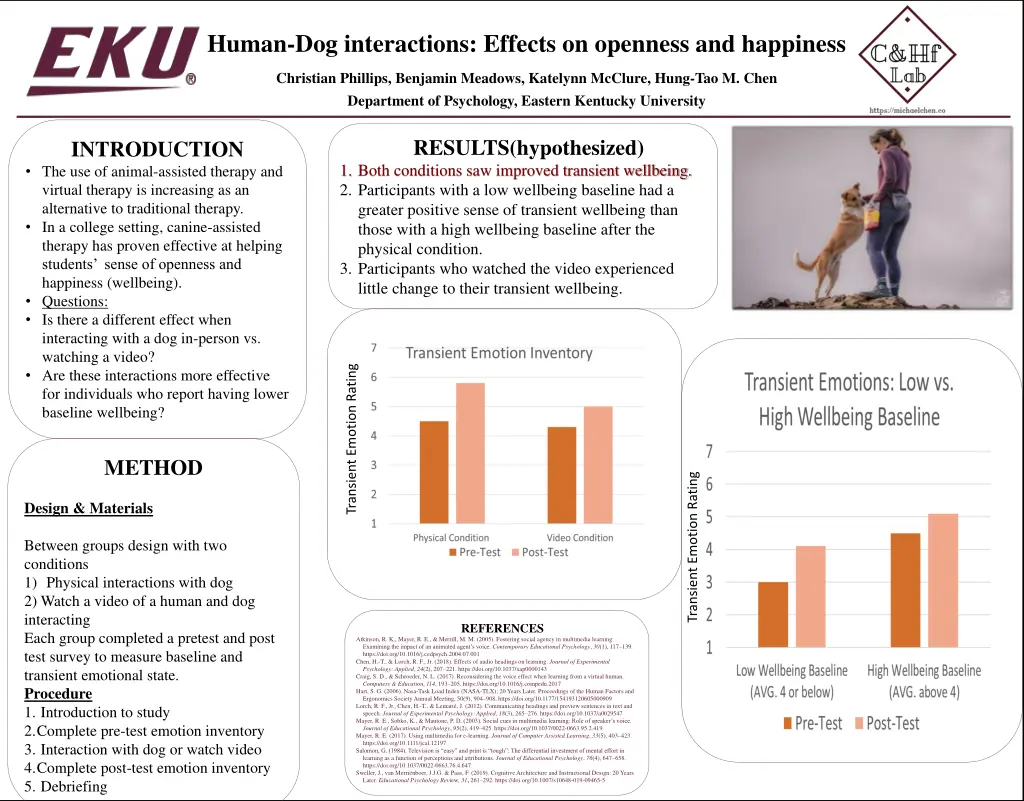
Effects of Human-Dog Interactions on Wellbeing
Explore the impact of human-dog interactions on openness and happiness, comparing in-person interaction with watching a video in a college setting. Results suggest improved transient wellbeing, with greater effects on individuals with lower baseline wellbeing. Animal-assisted therapy is becoming popular as an alternative to traditional therapy.
Uploaded on | 1 Views
Download Presentation

Please find below an Image/Link to download the presentation.
The content on the website is provided AS IS for your information and personal use only. It may not be sold, licensed, or shared on other websites without obtaining consent from the author. If you encounter any issues during the download, it is possible that the publisher has removed the file from their server.
You are allowed to download the files provided on this website for personal or commercial use, subject to the condition that they are used lawfully. All files are the property of their respective owners.
The content on the website is provided AS IS for your information and personal use only. It may not be sold, licensed, or shared on other websites without obtaining consent from the author.
E N D
Presentation Transcript
Human-Dog interactions: Effects on openness and happiness Christian Phillips, Benjamin Meadows, Katelynn McClure, Hung-Tao M. Chen Department of Psychology, Eastern Kentucky University RESULTS(hypothesized) 1. Both conditions saw improved transient wellbeing. 2. Participants with a low wellbeing baseline had a greater positive sense of transient wellbeing than those with a high wellbeing baseline after the physical condition. 3. Participants who watched the video experienced little change to their transient wellbeing. INTRODUCTION The use of animal-assisted therapy and virtual therapy is increasing as an alternative to traditional therapy. In a college setting, canine-assisted therapy has proven effective at helping students sense of openness and happiness (wellbeing). Questions: Is there a different effect when interacting with a dog in-person vs. watching a video? Are these interactions more effective for individuals who report having lower baseline wellbeing? Transient Emotion Rating METHOD Transient Emotion Rating Design & Materials Between groups design with two conditions 1) Physical interactions with dog 2) Watch a video of a human and dog interacting Each group completed a pretest and post test survey to measure baseline and transient emotional state. Procedure 1. Introduction to study 2.Complete pre-test emotion inventory 3. Interaction with dog or watch video 4.Complete post-test emotion inventory 5. Debriefing REFERENCES Atkinson, R. K., Mayer, R. E., & Merrill, M. M. (2005). Fostering social agency in multimedia learning: Examining the impact of an animated agent s voice. Contemporary Educational Psychology, 30(1), 117 139. https://doi.org/10.1016/j.cedpsych.2004.07.001 Chen, H.-T., & Lorch, R. F., Jr. (2018). Effects of audio headings on learning. Journal of Experimental Psychology: Applied, 24(2), 207 221. https://doi.org/10.1037/xap0000143 Craig, S. D., & Schroeder, N. L. (2017). Reconsidering the voice effect when learning from a virtual human. Computers & Education, 114, 193 205. https://doi.org/10.1016/j.compedu.2017 Hart, S. G. (2006). Nasa-Task Load Index (NASA-TLX); 20 Years Later. Proceedings of the Human Factors and Ergonomics Society Annual Meeting, 50(9), 904 908. https://doi.org/10.1177/154193120605000909 Lorch, R. F., Jr., Chen, H.-T., & Lemari , J. (2012). Communicating headings and preview sentences in text and speech. Journal of Experimental Psychology: Applied, 18(3), 265 276. https://doi.org/10.1037/a0029547 Mayer, R. E., Sobko, K., & Mautone, P. D. (2003). Social cues in multimedia learning: Role of speaker s voice. Journal of Educational Psychology, 95(2), 419 425. https://doi.org/10.1037/0022-0663.95.2.419 Mayer, R. E. (2017). Using multimedia for e-learning. Journal of Computer Assisted Learning, 33(5), 403 423. https://doi.org/10.1111/jcal.12197 Salomon, G. (1984). Television is easy and print is tough : The differential investment of mental effort in learning as a function of perceptions and attributions. Journal of Educational Psychology, 76(4), 647 658. https://doi.org/10.1037/0022-0663.76.4.647 Sweller, J., van Merri nboer, J.J.G. & Paas, F. (2019). Cognitive Architecture and Instructional Design: 20 Years Later. Educational Psychology Review, 31, 261 292. https://doi.org/10.1007/s10648-019-09465-5
Human-Dog interactions: Effects on openness and happiness Christian Phillips, Benjamin Meadows, Katelynn McClure, Hung-Tao M. Chen Department of Psychology, Eastern Kentucky University INTRODUCTION The use of animal-assisted therapy and virtual therapy is increasing as an alternative to traditional therapy In a college setting, canine-assisted therapy has proven effective at helping students sense of openness and happiness (wellbeing). Questions: Is there a different effect when interacting with a dog in- person vs. watching a video? Are these interactions more effective for individuals who report having lower baseline wellbeing?
Human-Dog interactions: Effects on openness and happiness Christian Phillips, Benjamin Meadows, Katelynn McClure, Hung-Tao M. Chen Department of Psychology, Eastern Kentucky University METHOD Design & Materials Between groups design with two conditions 1) Physical interactions with dog 2) Watch a video of a human and dog interacting Each group completed a pretest and post test survey to measure baseline and transient emotional state. Procedure Introduction to study Complete baseline & transient pre-test emotion inventory Interaction with dog or watch video Complete transient post-test emotion inventory Debriefing
Human-Dog interactions: Effects on openness and happiness Christian Phillips, Benjamin Meadows, Katelynn McClure, Hung-Tao M. Chen Department of Psychology, Eastern Kentucky University Transient Emotion Rating
Human-Dog interactions: Effects on openness and happiness Christian Phillips, Benjamin Meadows, Katelynn McClure, Hung-Tao M. Chen Department of Psychology, Eastern Kentucky University Transient Emotion Rating
Human-Dog interactions: Effects on openness and happiness Christian Phillips, Benjamin Meadows, Katelynn McClure, Hung-Tao M. Chen Department of Psychology, Eastern Kentucky University RESULTS 1.Both conditions saw improved transient wellbeing. 2.Participants with a low wellbeing baseline had a greater positive sense of transient wellbeing than those with a high wellbeing baseline after the physical condition. 3.Participants who watched the video experienced little change to their transient wellbeing.
Human-Dog interactions: Effects on openness and happiness Christian Phillips, Benjamin Meadows, Katelynn McClure, Hung-Tao M. Chen Department of Psychology, Eastern Kentucky University Questions/Feedback Christian_phillip38@mymail.eku.edu
Human-Dog interactions: Effects on openness and happiness Christian Phillips, Benjamin Meadows, Katelynn McClure, Hung-Tao M. Chen Department of Psychology, Eastern Kentucky University Binfet, J.-T., Green, F. L., & Draper, Z. A. (2021). The importance of client canine contact in canine-assisted interventions: A randomized controlled trial. Anthrozo s, 1 22. https://doi.org/10.1080/08927936.2021.1944558 Bolton, D., & Bhugra, D. (2020). Changes in society and Young People s Mental health1. International Review of Psychiatry, 33(1-2), 154 161. https://doi.org/10.1080/09540261.2020.1753968 Gee, N. R., Friedmann, E., Coglitore, V., Fisk, A., & Stendahl, M. (2015). Does physical contact with a dog or person affect performance of a working memory task? Anthrozo s, 28(3), 483 500. https://doi.org/10.1080/08927936.2015.1052282 Goldberg, L. R. (1993). The structure of phenotypic personality traits. American Psychologist, 48(1), 26 34. https://doi.org/10.1037/0003066x.48.1.26 Hills, P., & Argyle, M. (2002). The Oxford Happiness Questionnaire: A compact scale for the measurement of psychological well-being. Personality and Individual Differences, 33(7), 1073 1082. https://doi.org/10.1016/s0191-8869(01)00213-6 Owenby, B. E. (2016). The potential of animal-assisted therapy within the Supervisory Alliance. Journal of Creativity in Mental Health, 12(1), 146 159. https://doi.org/10.1080/15401383.2016.1184113 Pr gowski, M. P. (2015). Your dog is your teacher: Contemporary dog training beyond radical behaviorism. Society & Animals, 23(6), 525 543. https://doi.org/10.1163/15685306-12341383 Torous, J. B., Chan, S. R., Gipson, S. Y.-M., Kim, J. W., Nguyen, T.-Q., Luo, J., & Wang, P. (2018). A hierarchical framework for evaluation and informed decision making regarding smartphone apps for clinical care. Psychiatric Services, 69(5), 498 500. https://doi.org/10.1176/appi.ps.201700423 Trammell, J. P. (2019). Therapy dogs improve student affect but not memory. Anthrozo s, 32(5), 691 699. https://doi.org/10.1080/08927936.2019.1645514






















